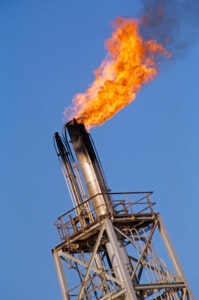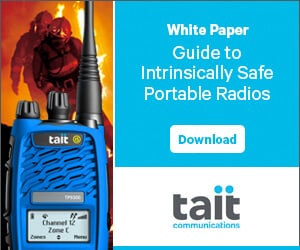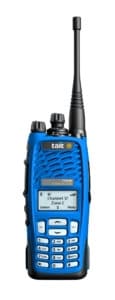In dangerous working environments, safety is not only a priority — it’s a requirement. When sending workers into hazardous areas, excellent communications are key to ensuring they remain safe. But the right communications can do more than just improve worker safety; they can also vastly increase efficiency, leading to greater return on investment for your organization.
Below are the challenges that workers in hazardous areas face and the recommended solutions that you may consider for your organization:
1) Challenge: Volatile Substances
A hazardous area may be defined wherever volatile or flammable substances, such as fuel, gas, or flammable dusts are present. Due to their potential of heat generation or sparking, hand-held communication devices must be chosen carefully so they do not cause an ignition.
Solution: Intrinsically Safe Devices
The International Electrotechnical Commission (IEC) standard for explosive atmospheres (Ex) equipment, the IEC 60079 series, is now the international benchmark. It is currently used in more than 30 IECEx member countries to define standards for Intrinsically Safe (IS).
IS equipment is required in a wide range of industries, from public safety and utilities, to mining, petrochemical and transportation. IS radios allow critical communications to be conducted in hazardous environments where use of non-IS radios would be potentially dangerous. When it comes to choosing an IS communications network, recent technological advances have provided organizations with more options than ever before.
It can be difficult to determine which purchases are not only best for your organization’s safety, but will offer maximum return on investment. The path to selecting the right system lies in understanding some of the challenges posed by hazardous environments, and the benefits the right products and solutions can offer.
2) Challenge: Connectivity
Hazardous areas, such as mines or oil fields, are often located in remote areas where cellular service can be patchy, if available at all. This is an issue because workers need to be connected to ensure personnel safety. Without connectivity, they can’t call for help, and you can’t send them critical information, such as site-specific risks they may encounter.
Solution: IS Portable Radio Device
Intrinsically Safe portable radios are designed to meet stringent international safety standards, meaning they can safely operate in hazardous areas. If the portable runs on a feature-rich network such as DMR Tier 3, not only will you get reliable voice communications, but also you can stay connected through packet data transference.
You can monitor their safety through things like Man Down or Lone Worker, and they can provide information such as temperature, chemical
detection, and other risk presence gathered from a site. As a result, workers have fast, reliable access to more data, improving their situational awareness and response, and leading to increased efficiency and safety.
3) Challenge: Extreme Conditions
Hazardous areas are defined as such because of their extreme conditions. Often, field workers are subject to extreme heat, moisture, shocks, jolts, and all manner of ruggedness. They need equipment that continues to function within these atmospheres because when communications equipment fails, production comes to a halt.
Solution: Tough Portable Radios
The devices these field workers use need to be as tough and rugged as the environments themselves. Tait Tough IS portable radios are engineered for demanding environments with IP67 rating and exceeding MIL standard specification. This means they can withstand all the shocks, drops, vibrations, moisture, and temperatures your employees put them through.
Not only is the hardware tough, but the software is tough as well. Each Tait radio goes through countless tests to ensure that when you push the talk button, you can communicate and keep your organization running.
4) Challenge: Security
Many organizations transfer sensitive data to various places and it needs to stay confidential. Interception in hazardous areas or dangerous situations can put employees at risk or lead to theft of critical data by competing or outside organizations.
Solution: Data Encryption
Networks such as the DMR Tier 3 platform support voice and data security features that ensure privacy for your workforce communications. Tait DMR portables also incorporate a Stun and Revive feature that enables network administrators to remotely disable radios should they be lost or stolen, further prohibiting data access for unauthorized users. Confidence that data can be transmitted and received securely enables your organization to concentrate on the task at hand.
5) Challenge: Environmental Awareness
In hazardous areas such as mines or oil fields, negative impact on the environment is always a risk. Sites with the potential for environmental harm, such as leaks or spills, must be monitored closely. In the event of an incident and subsequent audit, records and precautions must be proven. Keeping constant track of this data can be time-consuming and complicated. There is also threat to worker safety in areas where unexpected and unnoticed changes in the environment
can pose issues, such as noxious fume levels in mines or petrochemical plants.
Solution: Data Monitoring
Networks that support data transference and storage greatly increase efficiency by automating the monitoring process. Equipment can constantly monitor areas, such as chemicals in water or fumes in the air, and then relay this information back to control. This data tends to be quite small, and can even be transmitted over a DMR Tier 3 voice and data network.
Data can be stored and organized automatically, making it easy to recall when needed for audits or to look for business efficiencies. Customizable levels and limits can be set per your organization’s needs, and alerts or alarms automatically initiated if something exceeds those standards. With everything happening automatically, efforts can be focused on production.
What now?
Advancing technology continues to improve the way organizations communicate. As communications solutions develop, so too does the potential for greater efficiency.
To learn more a bout radio communications in hazardous areas, download the Guide To Intrinsically Safe Portable Radios.
bout radio communications in hazardous areas, download the Guide To Intrinsically Safe Portable Radios.
Read more about Tait Intrinsically Safe products and solutions to learn what benefits they can provide for your organization, or contact us today.
Sources:
HazardEx Magazine, September 2016
HazardEx On The Net
Mobile Connection in Hazardous Areas




